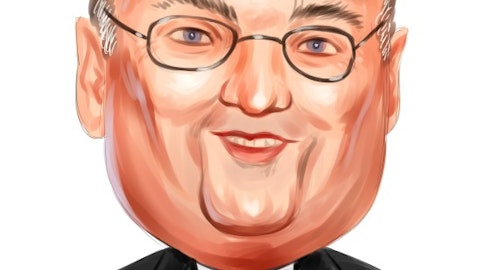Operator: Our next question comes from Meta Marshall from Morgan Stanley.
Unidentified Analyst: You’ve got Jamie on for Meta. I guess just 2 quick questions from my end. I guess, one, is there any sort of way we can kind of track the progress that you guys are getting with Maestro, either a number of customers on the platform or that sort of thing? And then as a follow-up, it looks like capital investment has picked up a little bit over the past couple of quarters. Should we look at recent trends as the new run rate?
David Morken: Yes. Thanks for your question. Enterprise customers and Maestro adoption continues really, really well. And while we haven’t called out specific numbers on our customers, the growth percentage-wise in these early days since going general availability back in August has been substantial. So we’ve talked in the past about that growth, and it is actually continuing to grow at that same rate or faster. So we haven’t decided if we’re going to call out Maestro adoption as a particular KPI, but enterprise customer additions and Maestro adoption continues to really be favorable.
Daryl Raiford: On the — Jamie, it’s nice to speak with you, and please give our regards to Meta. On the capital expenditures for the first quarter. Traditionally, we have incurred more in the first quarter or the first part of the year versus the last year. I think it’s a natural business phenomenon. Everyone has zeal and zest when it comes to the first part of the year and getting on with their investment plans. With that said, we are — we hold our guidance at around 3% of revenue for CapEx, and that’s what you all should be considering. I don’t take anything with the slightly higher amount in the first quarter.
Operator: Our next question comes from Ryan Koontz from Needham Company. Ryan, please proceed.
Ryan Koontz: Ask you about the messaging business? It sounds like that was broad-based in terms of your strength there, really strong growth on the cloud comms piece there. I assume that’s mostly U.S.-based, first question. And second here, as it relates to international, and your presence you gained from Voxbone. Can you expand on your thoughts about how that market develops for you going forward?
David Morken: Total messaging is up 50% year-over-year. Commercial showed strong growth of 34% year-over-year and enterprise momentum also really solid. So your question about domestic versus international. We recently announced international, which is part of our solution selling to large enterprise globally. And that’s a really positive and strong addition that rounds out our offer portfolio. However, these results do reflect the preponderance of the messaging growth domestically. So international is strong growth upside for us going forward. The second part of your question about international business generally continues to be a very real differentiator for us on both voice and now messaging footprint. Globally, our voice footprint is unsurpassed, and enterprises really value that single partner solution.
And now with messaging coming on alongside it globally, we expect the international business to continue to outperform our expectations, and we’re pleased with how it’s doing.
Ryan Koontz: So maybe I can interpret that. It sounds like your global presence has given you a lot of strength to win domestic deals to have an international reach and you’re planning to pivot more to direct international sales now a little harder?
David Morken: Well said.
Operator: Our next question comes from Patrick Walravens from Citizens JMP. Patrick, please go ahead.
Patrick Walravens: Great. So Dave, this question is going to seem a little unusual, but I think the context will be super helpful. So can you just step back and help people who don’t know the story that well, understand what’s been going on in this business over the last couple of years and how you’re positioned now? And just for context, I mean, the stock peaked at almost $190 in March 2021. Last year, went all the way down to 9% and change. And now at 42% year-to-date plus premarket is up another 9%. So just help us understand the big picture in terms of what has been going on, why there’s so much volatility and where we’re headed from here, not commenting on the stock where we’re headed from here. But where the business is headed from here?
David Morken: Thank you, Pat. Thanks for the opportunity to speak to the longer term and the background. So we enjoyed COVID tailwinds as did many in our space when remote work seem to become the foreseeable future. And those tailwinds certainly dissipated after the COVID era ended. Our whole space and peers were similarly impacted as valuations plummeted, but executing is really what matters. And I can’t answer the question about the last 2 years without appropriately tipping my hat to my Bandmate Anthony Bartolo, who is going to be the CEO someday soon of a powerful company somewhere. We can’t wait to see where that might be, and there’s certainly nothing to announce, but I want to say this, Anthony came on board and with Daryl Raiford, our CFO, articulated excellently our mid- and longer-term plans at our first ever Investor Day and we’ve executed ever since.
And this space is in the very early days of a transformation of taking 100 years of business telephony that has been premise-based, and migrating it to the cloud and doing so with platforms like Maestro, which allow them to abandon incumbent carriers and instead go completely software-driven with how they move calls and messages around the world. We are in the vanguard of companies that have helped these enterprises globally do that. And so I think we’re going to look back and see the COVID era spikes in valuation has been an anomaly in a much longer period of growth that fundamentally changes the way enterprise businesses do communications and voice and text. And again, the platform approach that we’ve taken, the leadership that Anthony and myself and Daryl have had in place over the last 2 years has contributed to the outperformance that you see today.
And if I’m an investor, and I’m looking at that pattern that you mentioned over time where we shot up and then created and now we’re crawling our way back out of that basement to a bright horizon, it would be with confidence that the macro technology shifts that we are a part of are going to persist and the team and the technology that we’ve built are durable for that future. So this is our 27th quarter of achieving the guidance that we put out to the world. And we hope and pray that we continue to do that against the backdrop of a very real technology shift in communications. So I hope that answers the question, Pat.
Operator: And our next question comes from Arjun Bhatia from William Blair. Arjun, please go ahead.
Arjun Bhatia: Perfect and great job on the quarter here. Maybe first to start with. I noticed that the net retention rate had a nice uptick from Q4 to Q1. It sounds like some of the usage growth is coming back, messaging a strong, enterprise is strong. Can you maybe just give us a sense of how net retention might progress through the year and embedded in that? I assume there’s also some Maestro, but would love to hear how that might benefit that net retention figure as we progress through the year here.
Daryl Raiford: Arjun, this is Daryl. It’s nice to hear from you. Let me just plainly say that we expect net retention to continue to grow. Over the last 18 months, we’ve spoke each quarter about churning small inconsequential customers from our customer base and replacing them each quarter with larger enterprise customers. On net retention, when we remove existing customers, there is no more net retention, and so that will lower the rate. But when in that same quarter, we’ve replaced them with other customers, it’s a year in the formula before net retention is reflected. It’s now been a year and going. We’re very happy with our enterprise customer outcome. Our average annual revenue per customer grew to the record $190,000 and we’re expecting through the year, net retention will be growing back to what a normal rates would have been, should have been had we not architected the churn over the last 18 months.
Arjun Bhatia: And then the other one I just wanted to touch on is gross margins. Again, I think you’ve called out that there will be a about 100 basis point improvement there year-over-year. But when I look at the Q1 performance, especially, it seems like there’s been some outperformance there. Again, can you just give us a sense for the puts and takes on gross margin? And I guess when I’m looking at this year and Q1 performance, maybe I’m extrapolating too much, but why can’t it be higher than 100 basis point improvement as we’re looking at 2024.


